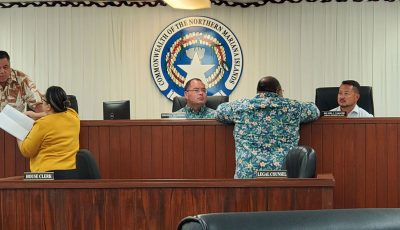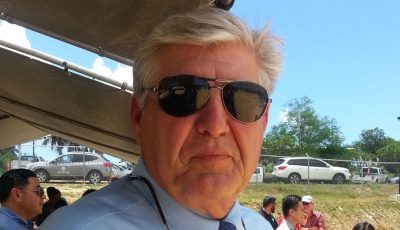House weighs options on Tinian, Pagan airspace

Commonwealth Ports Authority board chair Kimberlyn King-Hinds, center, approaches members of the House of Representatives as the joint committee meeting between the House Judiciary and Governmental Operations Committee and the House Federal and Foreign Affairs Committee concluded last Thursday afternoon. (Erwin Encinares)
The House of Representatives is weighing its options on Tinian and Pagan relating to the memorandum from the secretary of the Navy urging the Federal Aviation Administration to lift airspace limitations to allow live-fire training on both islands.
Members of the House committees on Federal and Foreign Affairs, led by chair Rep. Luis John “L.J.” Castro (R-Saipan), and Judiciary and Governmental Operations, led by chair Rep. Joel Camacho (R-Saipan), met last Thursday with Commonwealth Ports Authority board officials to get up to speed on the CPA-FAA-Navy issues on Tinian and Pagan’s airspace issue.
“…There are a lot of concerns, not just from the people of Tinian, but from the Commonwealth [in general],” Castro told Saipan Tribune. “It affects things such as commerce [through possible air freight disruptions]. …It’s something that everybody wants to get accurate information of, so this meeting was a way of clearing confusion that we may have as members of the Legislature as well as figuring out possible solutions to this.”
In an April 30, 2019, memorandum addressed to the FAA, Navy Secretary Richard Spencer asked that they be granted relief from the rule that does not allow the use of a restricted airspace 1,500 feet above ground level and within three nautical miles of a public airport.
A restricted airspace is airspace being used typically for military operations—including live fire training.
The Tinian International Airport is protected by FAA Order 7400.2L, which, according to Spencer’s memo, is within three nautical miles of the military leased area where the live-fire range complex will be located and restricted airspace placed above it.
“…The Navy is making a request as part of the CNMI Joint Military Training Program [also known as the CJMT]. This is aside and separate from the divert Tinian Airfield activities,” Commonwealth Ports Authority board chair Kimberlyn King-Hinds told Saipan Tribune.
She noted that the Navy’s intention to introduce a restricted airspace on Tinian would allow the Navy to conduct “high-hazard impact training” where they drop multiple inert bombs as well as conduct live ammunition training.
In two separate letters dated June 17, 2019, King-Hinds brought up this issue with Spencer and sought a response and information from FAA.
Rep. Sheila J. Babauta (Ind-Saipan) finds this heightened “militarization” of the Commonwealth troubling.
“I’ve been learning more and more about militarization in the Commonwealth and it troubles me,” she noted in a statement to Saipan Tribune. Babauta represents Saipan’s Precinct 4 and includes all of the Northern Islands as well.
“The military buildup [in] Guam will directly affect the CNMI because there’s now a need for additional training ranges to accommodate the troops.”
The military is looking to Tinian and Pagan for these training spaces, Babauta said, “and there are just certain types of training we should not support.,” she said.
Babauta believes the high intensity and high impact explosives the U.S. military plans to drop on these training spaces will damage the CNMI’s natural resources and greatly impact the lives of residents.”
She insists that the Commonwealth does support the U.S. military but “we [already] gave up one entire island in support of national defense,” referring to the entire island of Farallon De Medinilla.
She insists, though, that a line must be drawn when giving up natural resources and a quality of life unique to both Tinian and Pagan.
“We must voice our concerns and protect our Marianas,” she added.
Rep. Ivan Blanco (R-Saipan) told Saipan Tribune that while he welcomes the U.S. military’s presence and efforts to contribute to the CNMI economy, the thought of using live ammunitions on the islands is troubling.
“…The destructive portion of [the U.S. Navy’s] plans to bomb Pagan and use heavy artillery on Tinian is serious cause for concerns, including efforts to limit our economic engine, especially with restricting our airspace,” he said.



























